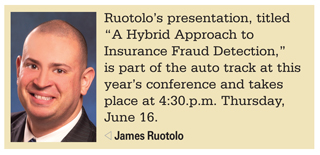 Minimizing fraud losses can be a daunting task, but withthe right strategy, your organization can nab more fraudsters thanyou might think. At America's Claims Event (ACE) this month, James Ruotolo,principal for insurance fraud at the SAS Institute, will present ahybrid approach to insurance fraud detection. Attendees at thisThursday afternoon session will learn to combine detection techniques, helping to minimize a false-positive ratewhile maximizing their available investigative resources.
Minimizing fraud losses can be a daunting task, but withthe right strategy, your organization can nab more fraudsters thanyou might think. At America's Claims Event (ACE) this month, James Ruotolo,principal for insurance fraud at the SAS Institute, will present ahybrid approach to insurance fraud detection. Attendees at thisThursday afternoon session will learn to combine detection techniques, helping to minimize a false-positive ratewhile maximizing their available investigative resources.“Individual detection methods each have value but tend toproduce a high false-positive rate on their own,” Ruotoloexplained. “Investigating false positives is a waste of limited SIUcapacity.”
|Ruotolo says that the biggest challenge today for specialinvestigation units (SIUs) is the need for a shift in thinkingand methodology to address organized fraud exposure. In thisinteractive session, Ruotolo will discuss the pros and cons ofvarious detection methods, how a hybrid approach can combine thebest features of each detection method, and how to overcome thehurdles to implementing a fraud detection technology program.
|“For years, the industry has relied almost exclusively onbusiness rules or 'red flags' to detect suspicious claims,” Ruotolosaid. “Furthermore, SIUs have been structured to handle singleclaim investigations. Detection and investigation of organizedfraud ring activity, such as staged accident fraud, requires moreadvanced technology to handle the large amount of data involved.” One technique Ruotolo will discuss is breakingdown silos via advanced data integration. Silos can exist in allparts of an organization and can create divisions within anSIU.
|“[Silos] might exist between underwriting and claims but couldalso exist between lines of business like auto and property,” heexplained. “Many organizations now have dedicated investigators orteams to focus on large multi-claim investigations.”
|According to studies by both the National Insurance Crime Bureau(NICB) and the Insurance Research Council (IRC), auto fraud hasbeen increasing significantly. On April 26, the NICB released areport asserting that vehicle collision questionable claimsincreased by 17 percent from 2009 to 2010, and related the numberto a 15 percent increase in bodily injury (BI) and personal injuryprotection (PIP) insurance claims during that same period. Thecorrelation suggests a link between suspicious vehicle collisionclaims and bodily injury claims.
|Organizations like the Coalition Against Insurance Fraud (CAIF) and the PA InsuranceFraud Prevention Authority help educate the public on thesematters, but Ruotolo says there is still work to be done.
|“Despite these efforts, research by the CAIF shows that a large(and increasing) percentage of American adults are tolerant ofinsurance fraud,” Ruotolo asserted. “And a recent study byAccenture suggests that poor customer service can cause individualsto commit fraud against their insurer.”
|
Want to continue reading?
Become a Free PropertyCasualty360 Digital Reader
Your access to unlimited PropertyCasualty360 content isn’t changing.
Once you are an ALM digital member, you’ll receive:
- All PropertyCasualty360.com news coverage, best practices, and in-depth analysis.
- Educational webcasts, resources from industry leaders, and informative newsletters.
- Other award-winning websites including BenefitsPRO.com and ThinkAdvisor.com.
Already have an account? Sign In
© 2024 ALM Global, LLC, All Rights Reserved. Request academic re-use from www.copyright.com. All other uses, submit a request to [email protected]. For more information visit Asset & Logo Licensing.








